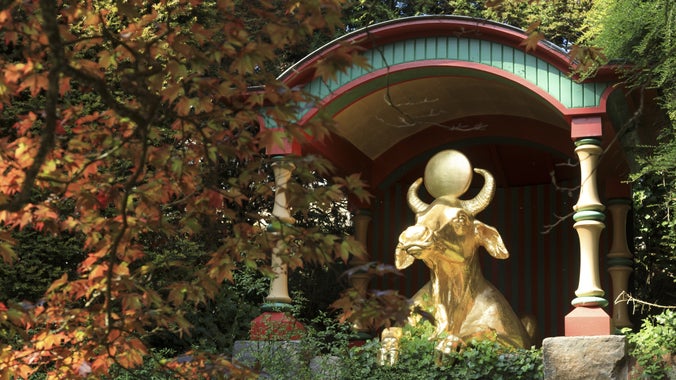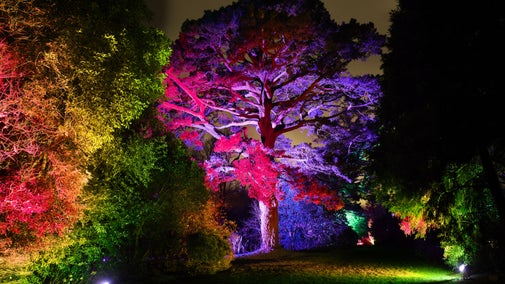
Where will you visit next?
Discover lots of gardens, historic houses, days out at the coast and more.
A masterpiece of Victorian garden design - a quirky, playful paradise
Grange Road, Biddulph, Staffordshire, ST8 7SD

| Asset | Opening time |
|---|---|
| Garden | 10:00 - 15:30 |
| Shop | 11:00 - 15:45 |
| Tea-room | 10:00 - 15:00 |
Last admission time 30 minutes before garden closing time.
| Ticket type | With Gift Aid | Without Gift Aid |
|---|---|---|
| Adult (18+) | £14.30 | £13.00 |
| Child (5-17) under 5s free | £7.15 | £6.50 |
| Family (2 Adults and up to 3 children) | £35.75 | £32.50 |
| 1 adult, 2 children | £21.45 | £19.50 |
| Group (Adult 18+) | £11.70 |
There are two sets of steps with a handrail up to the tearoom.
Available upon request or when advertised.
The garden is built on the side of a valley and has many gradients. There are narrow gravel paths, ledges, over 400 steps, gradients and dark narrow tunnels throughout the garden. For more detail please look at the Access Guide: https://www.accessable.co.uk/national-trust/biddulph-grange-garden-national-trust
Accessible route to parts of the garden highlighted on the welcome map from Visitor Reception
This is located by the shop
Located at Visitor Reception
50 yards for the visitor welcome point
Drop off by visitor welcome / shop
There are many gradients and over 400 steps all around the garden as well as tunnels and narrow paths.
Manual wheelchairs available to loan from Visitor Reception
Get into the festive spirit with a visit to Biddulph Grange this Christmas. Share special moments with those you love.

Find out how to best access Biddulph Grange Garden and how to make the most out of your visit.

Groups have been coming to Biddulph Grange since Victorian times. With guided tours and self-led visits, discover what makes this Grade I listed garden so special.

We offer the opportunity for special occasion and commercial photography. Advance booking is essential. For more details contact biddulphgrange@nationaltrust.org.uk or 01782517999.

An iconic garden, complete with a bright red pagoda and bridge, golden water buffalo statue set landscaped with colourful acer trees.
A unique Victorian display of fossils and geological strata laid out according to the Biblical days of creation, a fascinating journey through time.
The oldest stumpery in the country and the inspiration for many more. An atmospheric sunken path bordered by upside-down oak tree roots.
Hidden behind by hedges, sits a topiary pyramid and obelisks, guarded by two pairs of sphinx statues.
Disappear into the woods for adventure play for all ages. Experience the seasons as you enjoy the climbing frames, see-saw and balance beams.
Offering a variety of hot and cold drinks as well as delicious cakes and bakes. Sit in the former Billiard Room or enjoy outside seating.
As well as selling variety of gifts and souvenirs, there’s a plant centre stocked with seasonal planting themed to the garden.
Filled with pre-loved books in a wide variety of genres in both fiction and non-fiction. Enjoy browsing in the former Writing Room.
Let children's imaginations run free as they explore. Find out about upcoming events and features in the garden that are perfect for the whole family.

Groups have been coming to Biddulph Grange since Victorian times. With guided tours and self-led visits, discover what makes this Grade I listed garden so special.

Explore the garden where garden rooms lead into each other. See exotic plants, Grade II listed sculptures and seasonal blooms.

Discover all the seasons in just one relaxing walk! Using this trail, you will experience the splendour of the evergreen and golden autumnal hues through mysterious tunnels and scenic pathways.

Pick up a tasty treat in the tea-room, grab a must-have in the shop or select a second-hand book from the bookshop in the cherry orchard. Read all about eating and shopping at Biddulph Grange.

It's the 12 Days of Christmas but not as you remember! Find the 12 Days of Christmas with a special garden twist around Biddulph Grange Garden throughout December.
Join botanical artist Kate Dawes for relaxed Christmas themed pen and watercolour workshop that's suitable for all abilities.
Join the great Victorian novelist Charles Dickens as he brings to life one of the most famous ghost stories of all time.
Read about the people that shaped Biddulph Grange Garden, the people that created it and its legacy.

Discover more about the work currently being undertaken to care for Biddulph Grange Garden.

If you’re interested in volunteering at Biddulph Grange Garden, please keep checking for future opportunities.

Explore the objects and works of art we care for at Biddulph Grange on the National Trust Collections website.


Discover lots of gardens, historic houses, days out at the coast and more.
By sharing your email address you’re agreeing to receive marketing emails from the National Trust and confirm you’re 18 years old or over. Please see our for more information on how we look after your personal data.